
- Home
- Memories
- Scrapbook ▽
- Topics ▽
- People ▽
- Events
- Photos
- Site Map
- Timeline
Page updated 17 February 2009
Return to Industrial Exeter
 Of all the
Exeter firms on
this site, Garton and
King emerge as the one with the longest history. The company date their
beginnings to 1661 - in this year emerges one John Atken, former
apprentice ironmonger to Thomas Dixe, running his shop at the top of
Fore Street. An ironmongers then sold many goods including firedogs,
spits, saucepans, chain, bolts, nails equipment for horse and carriage,
gunpowder and lead for casting bullets. Brass, copper, wrought and cast
iron were the materials of the ironmonger. At this time, all shops
employed a swinging sign over the front to denote their business.
Atkens hung a Golden Hammer. The years after the Civil War were a
prosperous time for Exeter as the damaged city was repaired and trade
recovered through the improved canal. By his retirement in 1698,
Atken's had done well, and the business flourished.
Of all the
Exeter firms on
this site, Garton and
King emerge as the one with the longest history. The company date their
beginnings to 1661 - in this year emerges one John Atken, former
apprentice ironmonger to Thomas Dixe, running his shop at the top of
Fore Street. An ironmongers then sold many goods including firedogs,
spits, saucepans, chain, bolts, nails equipment for horse and carriage,
gunpowder and lead for casting bullets. Brass, copper, wrought and cast
iron were the materials of the ironmonger. At this time, all shops
employed a swinging sign over the front to denote their business.
Atkens hung a Golden Hammer. The years after the Civil War were a
prosperous time for Exeter as the damaged city was repaired and trade
recovered through the improved canal. By his retirement in 1698,
Atken's had done well, and the business flourished.
It was John Southcombe from Chudleigh who took over the ironmongers shop. In 1706 he employed an apprentice of his own, a young Lewis Portbury. They became friends and in 1708 Portbury married Elizabeth, Southcombe's niece.
In 1709 Abraham Darby produced a higher quality iron in a coke-fired furnace at Coalbrookdale. This new process produced thin castings that could compete with brass in such applications as the manufacture of pots and other hollow ware. Southcombe contacted Darby and purchased his hollow-ware for his shop. The local Exeter product was inferior in quality, and this new material gave Southcombe an advantage over his rival traders.
Southcombe died in 1724, and left Portbury a small fortune in both goods and money. Portbury had done well, running the business with Southcombe and had been appointed Bailiff for the City in 1719 and Churchwarden of St Petrock's in 1721. His son, also Lewis joined the business and by the time of his father's death in 1732, was ready to take over.
Like all young men, Lewis had progressive ideas - coal was becoming available in Exeter, imported along the canal from Newcastle. He started selling basket-grates for burning coal. By 1740 he was selling hob-grates with a roasting spit and 2 top plates for a kettle and pan. In the previous century, tea and coffee were imported for the first time - by the early 18th Century these beverages were becoming popular, creating a trade in and coffee pots, urns and tea-kitchens. The new methods of manufacture also found their way into cast iron plough-shares and other agricultural tools.
At this time, men of trade could find their way to the top of society - Lewis Portbury was no exception and was Sheriff of the City in 1746, and in 1748 Mayor. He was also a Justice of the Peace. Quite an achievement for an ironmonger. He died in 1766 which the then new Trewins' Exeter Flying Post reported thus:
"On Wednesday last, aged 58, died Lewis Portbury, a tradesman in whose character he acquired a handsome fortune with the greatest reputation."
In 1767 the business was put up for sale. Again the Flying Post reported:
"June, 1st,
1767.
To be let for a term of nine years from Midsummer next. All that
dwelling house situate in Fore Street near the Conduit, lately in the
possession of Mr. Alderman Portbury, deceased, consisting of a very
convenient shop and passage adjoining, with a Parlour, Kitchen and
Pantry behind same; a very good Cellar under the Shop and Passage, a
large Dining Room, Lodging Room, Wareroom and Closet on the Second
Floor, with four Garrets over the same and a Balcony at the top of the
House which commands an extensive view and a pleasant prospect of the
River Exe. For which purpose a survey will be held for letting the same
on Monday the 15th day of this instant June, by Three o'clock in the
afternoon at the Bear Inn in Southgate Street, where the best bidder
will have a reasonable price given. For further Particulars apply to
Mr. Thomas Coffin, joiner, without Southgate, Exon."
A William Britnall took on the business. His was a short lived interest in ironmongery for he was bankrupt the next year.
At Midsummer 1768 the Flying Post reported:
"Samuel Kingdon, ironmonger and haberdasher of small wares, who lately lived with Mr. Coffin in Exeter. That he has taken the house with the stock-in-trade in which Mr. William Britnall lately lived at the sign of the Golden Hammer, four doors above the Conduit in Fore Street, where he sells all sorts of ironmongery and haberdashery goods, wholesale and retail."
Kingdon and his sons left a formidable legacy to the City of Exeter. From a family of eight children, from Thorverton he was apprenticed to Mr Coffin. In the same year he married Jane Kent, the daughter of William Kent of Oxford. In 1787 Samuel Kingdon expanded the business by opening a warehouse in Theatre Lane (now Waterbeer Street) selling copper goods and to buy and sell scrap metal. The business was also embarking on manufacturing grates and soon after, simple cooking ranges.
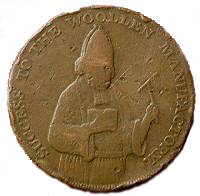
It was in 1792 that the Exeter Halfpenny was issued by Kingdon, a sort of private currency to be used in his warehouse and shop.
In November 1797, Samuel Kingdon died, leaving his widow Jane the task of running the business until his sons could take over. In 1804, Samuel Kingdon II joined his mother and brother William in the Kingdon & Sons. The manufacture of iron products was increased at this time in another building in Waterbeer Street known as the Old Guildhall.
The foundry and smiths' shop were taking on foundry workers, blacksmiths and whitesmiths. An innovation was the introduction of a steam engine to drive the bellows, enabling higher temperatures to be obtained, and quality to be improved. In 1813, two years before the Exeter Gas Light & Coke Company was formed, gas lighting was introduced in the premises. In 1816, Jane Kingdon died leaving the business in the sole charge of her two sons.
Business had suffered a loss of custom during the Napoleonic Wars, but after Waterloo, trade across Europe gradually recovered. The introduction of gas into Exeter after 1815 and the growth of Exeter as a centre for the south-west ensured that the Kingdon foundry had plenty of work.
So many histories of Exeter firms contain a disastrous fire, and Garton & King is no exception. Their fiery destruction occurred in October 1826 when the foundry and smithy were consumed by fire. Part of the Exeter Flying Post report went:
"...and the flames bursting upward the whole of this vast building, three storeys high with an attic, extended 150 feet in length, became one immense body of fire, which, the wind being high, was vomited forth with a bellowing that strongly reminded those present of the descriptive accounts of volcanic eruptions;"
The insurance payment from the West of England Insurance Company (now CGNU Plc) was £1,500, a not inconsiderable amount in those days. The foundry was re-established in premises that were formerly the Episcopal Charity School, also in Waterbeer Street. The business flourished along with the Kingdon brothers - Samuel or Iron Sam as he was known, was Mayor of Exeter in 1836, and William, Sheriff of the City in 1842.
In 1849, the brothers retired and after 81 years of the Kingdon’s, the business was sold to the established partnership of Ambrose Parker Jarvis and John Garton, who had formed Garton & Jarvis in 1836. This business had specialised in wrought-iron work, gates, railing, grates, and fenders. At the time of the sale, Kingdon & Sons had developed an expertise in greenhouse heating. The two businesses complemented each other.
At the Great Exhibition of 1851, Garton & Jarvis, as the whole was named, won two bronze medals for their stoves, and a commendation from Prince Albert, who had installed ‘Cottage’ stoves in his Model Cottages in Hyde Park. From that time they displayed the Arms of Royal Appointment.
The firm increased its output of stoves, using the latest methods of production, and Golden Hammer products were exported all over the world.
Many wrought iron gates and railings from Garton & Jarvis were installed around Exeter, including the Cathedral Green, the Royal Clarence and the Deer Stalker statue in Northernhay Park. Sadly, most of this work was lost in the Second World War when it was removed for war production. They were also one of the first firms to produce coil and cast-iron radiators.
Time rolled on and in 1865, Ambrose Jarvis died - John Gould King from Barnstaple joined the firm and it was renamed Garton & King. Two years after the name change, John Garton died - a new partner named Munk briefly joined the firm creating King & Munk, but this was not a success, the partnership dissolved, and the Garton & King name reinstated.
In 1898, the 36 year old Hugo Holladay from Kent joined into a partnership with John King - this time there was no name change. Holladay proved himself a good businessman, and when John King died in 1900, he was joined by his brother Edgar Holladay, who took on the engineering side of the company. The shop found it easier to purchase in for retail, and the output of the foundry dwindled. The business survived the First World War and in 1924 it was registered as a limited liability company. A pick up in business in the 1920's allowed the foundry to expand producing parts for gas stoves and contract work for small builders and councils.
In 1933, the year that Hugo Holladay retired, the shop at 190 High Street, that had served for 270 years was vacated and became Woolworths (now HMV), and the Golden Hammer taken down and hung over the Waterbeer Street foundry. Although the Guildhall Centre was not constructed until the 1970's, the city council had plans in the 1930's to clear out the area of Waterbeer Street and in 1936 served a compulsory purchase order on the foundry, to make way for a new Civic Centre. After much consideration a new foundry was built in Tan Lane, St Thomas, and a showroom opened at Central Station.
The foundry had plenty of work during the Second World War, and gave assistance to Parkin & Sons, whose premises were bombed out. Edgar Holladay died in 1943 after 43 years running the engineering side of the business. His bother Hugo died in 1946 and the company continued under Henry and Alec Hugo Holladay. The Central Station premises were vacated in 1957 and a new showroom opened in North Street - this is the shop that exists today. The Tan Lane foundry has closed and the company of Garton King Appliances now concentrates on selling, maintaining and installing Aga and Rayburn cookers from their showrooms in North Street and Darts Farm Village.
If you enter the North Street shop now, the range of products for sale are just as varied as those that John Atken sold in 1661 - in fact Atken would probably recognise some of the equipment, and reflect that his small shop had lasted rather well!
Sources - The Golden Hammer by S E Ellacott. I would like to thank Richard Holladay for permission to use the illustrations from the Golden Hammer. © 2005 David Cornforth - not to be reproduced without permission.
 Garton
& King in Waterbeer Street 1935
Garton
& King in Waterbeer Street 1935
Film kindly provided by the Holladay family
 The Golden Hammer over the
Garton and King shop in North Street.
The Golden Hammer over the
Garton and King shop in North Street.
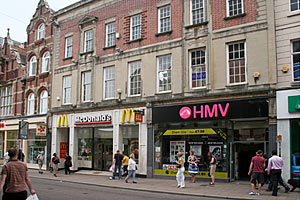 Woolworth's occupied
Garton and King's shop when the company moved out
in 1933. McDonalds and HMV now occupy the building.
Woolworth's occupied
Garton and King's shop when the company moved out
in 1933. McDonalds and HMV now occupy the building.
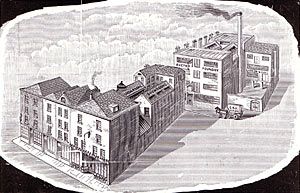 Garton and King's shop
and foundry at the rear, in Waterbeer Street.
Garton and King's shop
and foundry at the rear, in Waterbeer Street.
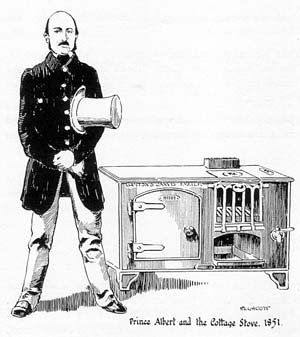 Prince Albert's image was used
alongside the Cottage Stove to promote
it.
Prince Albert's image was used
alongside the Cottage Stove to promote
it.
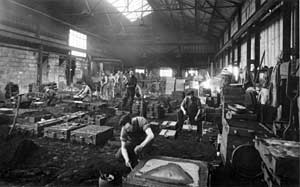 Inside
the Tan Lane foundry, circa 1950s. Courtesy of Richard
Holladay.
Inside
the Tan Lane foundry, circa 1950s. Courtesy of Richard
Holladay. 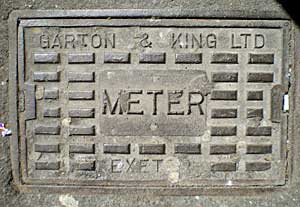 A manhole cover in Fore
Street cast by Garton and King.
A manhole cover in Fore
Street cast by Garton and King.
Richard Holladay is researching Garton and King, and would like to hear from anyone who has photographs, documents or memories of the company. If you know the whereabouts of a Garton and King manufactured stove, pump or other artifact, Richard would like to know so that he can photograph it. Contact me on my email below.
See Exeter Foundry, the official Garton and King history.
│ Top of Page │